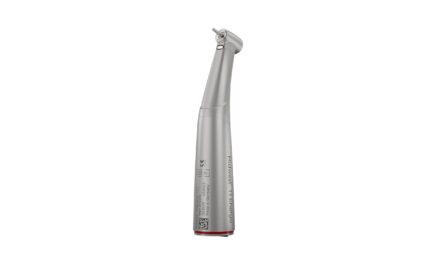by Leslie Canham, CDA, RDA
New infection-control products from the ADA Annual Session
 |
Today’s busy orthodontic practices must be concerned with infection control to meet dental board requirements and to measure up to the patient’s safety expectations. With so many different products available today, it can be overwhelming to keep up with the newest technology. In an effort to find better, faster, and safer ways to enhance infection control in dentistry, I attended the 2007 ADA scientific session in San Francisco. I dedicated an entire day to locating products and devices that would help simplify infection control and maximize safety.
Get Steamed (Or Not)
I discovered that two new steam sterilizers will be available soon, pending FDA approval. These new sterilizers claimed to be faster and to help improve efficiency of sterilizing instruments. The first new steam sterilizer is from Midmark and is called the M3 Ultrafast™. The manufacturer claims that this sterilizer will sterilize unwrapped instruments and handpieces in 5 and 1/2 minutes. This method of sterilizing unwrapped instruments, sometimes called flash sterilization, is used for sterilizing patient care items for immediate use. The M3 Ultrafast has another cycle for pouched instruments that sterilizes in 11 minutes. The chamber surface heaters remove moisture during the dry cycle, which will dry instruments in 40 minutes. This eliminates the need to empty the sterilizer contents on the counter to dry. Instrument packs should be allowed to dry inside the sterilizer chamber before removing and handling. Packs should not be touched until they are cool and dry because hot packs act as wicks, absorbing moisture—and, hence, bacteria—from hands.1 The M3 Ultrafast is automatic, meaning the operator does not have to monitor the sterilizer. At the end of the cycle, the patented opening door opens to begin the drying process.
The second new steam sterilizer is from SciCan and is called the Statim® 7000. You may be familiar with the smaller Statim 2000, which holds 2,000 cc of water; and the Statim 5000, which is bigger and holds 5,000 cc of water. The Statim 7000, as you might expect, is the largest of the three and holds 7,000 cc of water. It accommodates two 8- x 11-inch cassettes plus room for handpieces. One of its best features is that it can use regular tap water because it has a built-in water-filtration system. Instruments are steam-sterilized and then dried by superheated steam. The unwrapped cycle takes 15 minutes, and the wrapped cycle takes 30 minutes. This machine has built-in diagnostics and warning systems for filter-replacement and routine maintenance scheduling. It also has radio frequency identification (RFID) technology, a built-in antenna that tracks performance and parts status. For example, when the seal is due for replacement, a message is sent to the digital panel informing the operator of how many cycles remain before the system shuts down. This machine also has a modular design, which means that parts can be sent to the manufacturer instead of shipping the entire sterilizer out for repairs.
 |
| The Midmark M3 Ultrafast will be available soon. |
For practices that prefer to use dry heat, a new sterilizer to consider is the Dentronix DDS 7000 Dry Heat Sterilizer. It features a HEPA filter to provide purified air during the cool-down cycle. Also, instruments cool down inside the sterilizer chamber so they can be handled immediately after sterilization. Should the sterilization cycle fail, an error code on an LED panel informs the operator of the reason for the failure. For example, if someone opens the sterilizer door to add another instrument, the cycle will be aborted and the error code will display the reason for the interruption.
Easy Hand Hygiene
After learning about the new sterilizers, I began navigating the ADA marketplace in search of other infection-control products. The first item I came across was a personal, wearable alcohol gel dispenser for hand hygiene. Having immediate access to an alcohol hand rub can help dental health care workers comply with hand-washing regulations. The Centers for Disease Control and Prevention (CDC) lists hand hygiene as the single most critical measure for reducing the risk of transmitting organisms to patients.1 Washing hands is required before donning gloves and every time gloves are removed. In a typical orthodontic practice, that could mean washing hands 100 times per day or more! CDC states that if hands are not visibly soiled, an alcohol-based hand rub is adequate.
The product, called gelFASTTM Anywear by Unimed-Midwest, is a cartridge containing an alcohol-based hand rub that could be worn as a necklace or clipped onto a clinical jacket. Wearing the cartridge of hand rub would be more convenient than walking to a wall-mounted or countertop dispenser. You squeeze the cartridge to dispense the gel into your hands and then rub the product in, coating all the surfaces of the hands and fingers for about 15 seconds. The product is 70% Ethyl Alcohol and has multiple skin conditioners to keep hands in good shape.
Dry Field Innovations
The next items that caught my eye were products that help control moisture for orthodontic procedures that require a dry field. The first product, called Mirror-VacTM by IndiGreen Innovations, is a mouth mirror and saliva ejector in one. This unique instrument could eliminate the saliva ejector for certain procedures. This means one less item in the patient’s mouth and one less item to clean after each patient.
The second item, called Dry Tips® by Molnlycke Health Care, is a patch about the size of an x-ray film. Its purpose is to absorb moisture, and if you position it on the buccal mucosa, it adheres to the tissue and remains in place. The patch absorbs saliva up to 30 times its weight and, unlike cotton rolls and other pads, does not lose moisture when handled. At the end of the procedure, the patch can be removed with a spray of water and does not leave fibers or other residues behind.
Disinfectant Duo
As I searched for more products to simplify infection control, I saw disinfectant sprayer bottles with battery-operated sprayers. There were two of these: Touch-n-Spray by Kerr Total Care and Dynamic 1-Touch™ by Palmero Health Care. They have ergonomic, motorized heads that eliminate “trigger pulling” to spray disinfectant. A single touch dispenses a continuous spray or stream of disinfectant. This can reduce hand and wrist fatigue and eliminate repetitive-motion injuries. Palmero Health Care even sells a sprayer gun connected to a fanny pack that holds the disinfectant solution. This would be convenient for the assistant responsible for disinfecting equipment and surfaces.
Another unique product is a disinfectant wipe that is sold dry and is then activated by adding a liquid disinfectant called Optim 33 by Scican. The benefit of this product is that you can remoisten the wipes as needed. The disinfectant is an accelerated hydrogen peroxide-based product that has no health warnings and is generally regarded as safe. Other liquid disinfectant products do not allow storage of their product in containers with gauze or towels. In general, cotton fibers contained in gauze may shorten the effectiveness of some disinfecting agents when stored in containers together. Germicides, especially iodophors or chlorines, may be inactivated or absorbed by the gauze. As such, disinfectants should not be stored in containers with gauze. If used to apply disinfectant to surfaces, gauze should be saturated with the disinfecting agent at the time of use.2
Cleaner Machines
At my next stop I found Hygienic Keyboard and Mice by Man and Machine. More and more orthodontists have computers in their treatment rooms, and they face challenges in keeping traditional keyboards and mice clean. Cleaning and disinfecting all those nooks and crannies takes considerable time and effort. Even placing and removing plastic barriers on keyboards and mice is time-consuming. These new hygienic keyboards are constructed from a nonporous silicon rubber built to withstand disinfectant solutions. The mouse is a fully sealed optical mouse. Using these two items makes it simpler to keep the computer keyboard and mouse clean, and also helps prevent cross-contamination, which will better protect the patient, the clinical assistants, and the computer itself.
As I walked farther along, the next product was an ultrasonic cleaning system called the BioSonic® UC 125 by Coltène Whaledent. This unit has a digital readout called LCD technology. Having LCD technology on an ultrasonic unit can simplify the dental assistant’s job. First, the timer can be set for customized clean times. A countdown readout shows exactly when the instruments will be done. There is also a solution-tracking system, so there is no guessing how long the solution has been in use. The machine has a Degas cycle, which should be used to prepare new solutions for more effective cleaning. Another feature of this tank is that it is very quiet, operating at 63 decibels. (Normal breathing is approximately 10 decibels, and a normal conversation is at about 60 decibels.)
The next device I saw was a rapid 24-hour, in-house spore-testing kit for steam sterilizers called Spore CheckTM by Hu-Friedy. Biological indicators, also known as spore tests, are the most accepted method for monitoring the sterilization process.1 Most spore testing kits require the dental office to mail the test strip out. Results of the spore testing may not be discovered for as long as a week. The in-house kit shows results within 24 hours. With many orthodontic practices performing miniscrew implants, it is essential to know that the sterilized devices can be confirmed sterile within 24 hours.
Your patients trust you to sterilize instruments and implants to protect them from infectious diseases. When instruments are removed from an autoclave bag or cassette in front of the patient, the message is loud and clear that infection control and correct sterilization processes are important in your practice. Upgrading your sterilization and infection-control procedures with new state-of-the-art technology and products will help protect patients, dental health care workers, and the reputation of your practice.
Leslie Canham, CDA, RDA, is a dental speaker and consultant specializing in infection control and OSHA compliance. She has more than 36 years of experience in dentistry. She is the founder of Leslie Canham Seminars, providing in-office training, mock-inspections, consulting, and online seminars and Webinars to help the dental team navigate state and federal regulations. She can be reached at or (888) 853-7543.
References
- Kohn WG, Collins AS, Cleveland JL, et al. Guidelines for infection control in dental health-care setting—2003. MMWR Recomm Rep. 2003;52(RR-17):1-61. Available at: www.cdc.gov/mmwr/preview/mmwrhtml/rr5217a1.htm. Accessed October 4, 2007.
- Molinari J. Frequently asked questions for disinfection. Available at: www.osap.org/displaycommon.cfm?an=1&subarticlenbr=78#11. Accessed October 7, 2007.









